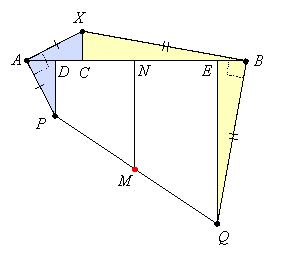- Prev
- Page 7 of 7
Example 6: Points A and B are 10 units apart. A point X is chosen on an arc with endpoints A and B, and points P and Q are located on the same side of this arc so that angles PAX and PBX are right angles, AP = AX, and BQ= BX. Then the midpoint M of PQ is located:
 |
What is the locus of M as X moves from A to B along the arc?
Solution:
Draw PD, XC, MN, and QE perpendicular to AB:

Then triangles ACX and PDA are congruent, as are triangles BCX and QEB. So XC = AD and XC = BE. Since M is the midpoint of side PQ in trapezoid DPQE (the white region), MN is its midsegment and therefore its length is the average of lengths DP and EQ. But DP = AC and EQ = CB, so DP + EQ = AB = 10, and therefore MN = 5. But N is the midpoint of DE and therefore the midpoint of AB (since AD = EB). Thus M is 5 units below (perpendicular) AB's midpoint. That is, the locus does not depend on the location of X and is a single point. The fact that X is on some arc connecting A and B is irrelevant.